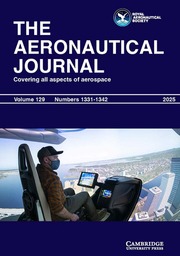Crossref Citations
This article has been cited by the following publications. This list is generated based on data provided by
Crossref.
Sarkar, A.
Nitin, N.
Karwe, M. V.
and
Singh, R. P.
2004.
Fluid Flow and Heat Transfer in Air Jet Impingement in Food Processing.
Journal of Food Science,
Vol. 69,
Issue. 4,
p.
CRH113.
Bhattacharjee, Pratik
and
Loth, Eric
2004.
Simulations of laminar and transitional cold wall jets.
International Journal of Heat and Fluid Flow,
Vol. 25,
Issue. 1,
p.
32.
Field, Brandon S.
and
Loth, Eric
2004.
An Air Curtain Along a Wall With High Inlet Turbulence.
Journal of Fluids Engineering,
Vol. 126,
Issue. 3,
p.
391.
Cao, Guangyu
Kurnitski, Jarek
Ruponen, Mika
and
Seppänen, Olli
2009.
Experimental Investigation and Modeling of the Attached Plane Jet Velocity Development Characteristics in the Transition Process in a Room.
HVAC&R Research,
Vol. 15,
Issue. 3,
p.
489.
Cao, Guangyu
Ruponen, Mika
and
Kurnitski, Jarek
2010.
Experimental investigation of the velocity distribution of the attached plane jet after impingement with the corner in a high room.
Energy and Buildings,
Vol. 42,
Issue. 6,
p.
935.
Cao, Guangyu
Sivukari, Markku
Kurnitski, Jarek
Ruponen, Mika
and
Seppänen, Olli
2010.
Particle Image Velocimetry (PIV) application in the measurement of indoor air distribution by an active chilled beam.
Building and Environment,
Vol. 45,
Issue. 9,
p.
1932.
Cao, Guangyu
Sivukari, Markku
Kurnitski, Jarek
and
Ruponen, Mika
2010.
PIV measurement of the attached plane jet velocity field at a high turbulence intensity level in a room.
International Journal of Heat and Fluid Flow,
Vol. 31,
Issue. 5,
p.
897.
Cao, Guangyu
Ruponen, Mika
Paavilainen, Risto
and
Kurnitski, Jarek
2011.
Modelling and simulation of the near-wall velocity of a turbulent ceiling attached plane jet after its impingement with the corner.
Building and Environment,
Vol. 46,
Issue. 2,
p.
489.
Skupsch, C.
Klotz, T.
Chaves, H.
and
Brücker, C.
2012.
Channelling optics for high quality imaging of sensory hair.
Review of Scientific Instruments,
Vol. 83,
Issue. 4,
van Hooff, T.
Blocken, B.
Defraeye, T.
Carmeliet, J.
and
van Heijst, G. J. F.
2012.
PIV measurements of a plane wall jet in a confined space at transitional slot Reynolds numbers.
Experiments in Fluids,
Vol. 53,
Issue. 2,
p.
499.
Samaha, Mohamed A.
Tafreshi, Hooman Vahedi
and
Gad-el-Hak, Mohamed
2012.
Influence of Flow on Longevity of Superhydrophobic Coatings.
Langmuir,
Vol. 28,
Issue. 25,
p.
9759.
Cao, Guangyu
Kandzia, Claudia
Müller, Dirk
Heikkinen, Jorma
Kosonen, Risto
and
Ruponen, Mika
2013.
Experimental study of the effect of turbulence intensities on the maximum velocity decay of an attached plane jet.
Energy and Buildings,
Vol. 65,
Issue. ,
p.
127.
Kaffel, Ahmed
Moureh, Jean
Harion, Jean-Luc
and
Russeil, Serge
2015.
Experimental investigation of a plane wall jet subjected to an external lateral flow.
Experiments in Fluids,
Vol. 56,
Issue. 5,
Ramalingam, N.
and
Das, S. P.
2020.
Instabilities of Decaying Flow in a Rectangular Channel.
Journal of The Institution of Engineers (India): Series C,
Vol. 101,
Issue. 5,
p.
821.
Arackal, Rahul S.
and
Jothi, T. J. S.
2021.
Surface pressure fluctuations in wall jets with different plate lengths.
Experiments in Fluids,
Vol. 62,
Issue. 11,
Nie, Xin
Zhu, Zehui
Liao, Haibo
Lü, Ming
and
Xu, Jiangrong
2021.
A comparative study of heat transfer characteristics of wall jet with boundary layer transition using six low-Reynolds number k–ε models.
AIP Advances,
Vol. 11,
Issue. 2,
Ramalingam, N.
and
Das, S. P.
2025.
A short laminar separation bubble over a rounded backward facing step.
Acta Mechanica,
Shadkam, Arman
Pouransari, Zeinab
and
Rasam, Amin
2025.
The turbulent/non-turbulent interface in wall-jets.
Physics of Fluids,
Vol. 37,
Issue. 9,
Arackal, Rahul S.
Arun, M.G.
Sumesh, C.K.
and
Jothi, T.J.S.
2025.
Acoustic characteristics of wall jets in the developing regime.
International Journal of Aeroacoustics,

